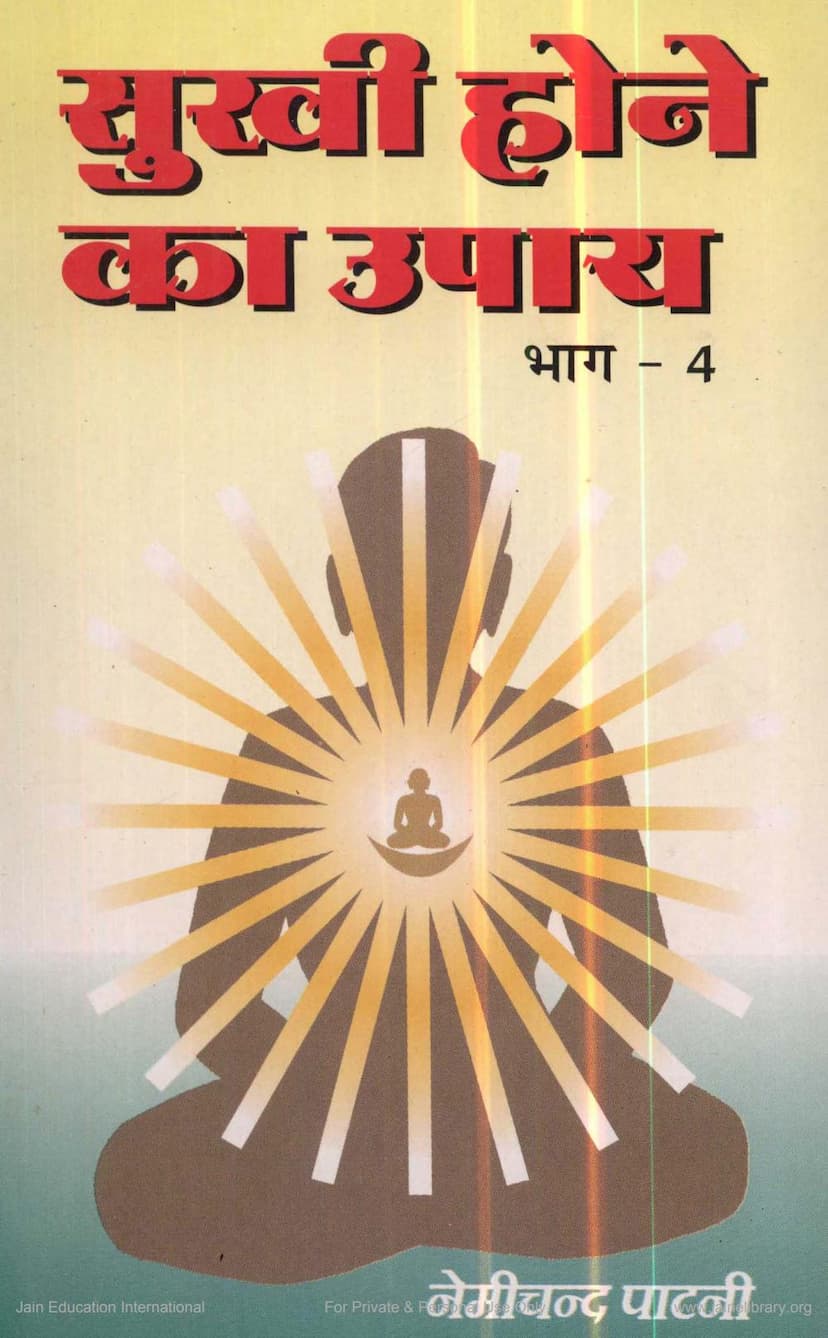Sukhi Hone Ka Upay Part 4
Added to library: September 2, 2025

Summary
Here is a comprehensive summary of the Jain text "Sukhi Hone ka Upay Part 4" by Nemichand Patni, based on the provided catalog link and page content:
Book Title: Sukhi Hone ka Upay Part 4 (The Way to Be Happy, Part 4) Author: Nemichand Patni Publisher: Todarmal Granthamala, Jaipur Catalog Link: https://jainqq.org/explore/001865/1
Core Theme: This book, the fourth in a series on achieving happiness, focuses on the crucial aspect of "The segregation of the knowable substance (Jneyatattva) from the knowing substance (Jñātṛtattva) through accurate decision-making." It elaborates on achieving true happiness by understanding the self (Jiva) as the knowing substance and differentiating it from all knowable objects (Jeya), including one's own transient states.
Key Concepts and Structure:
The book is structured to guide the reader towards self-realization and the path to true happiness, which in Jain philosophy is inherent peace and freedom from suffering (nirākulatā). It builds upon the foundational principles established in the previous volumes, which covered the nature of substances, the internal state of the soul, and the importance of decision-making.
Part 4 delves into the following key areas:
-
The Nature of Truthful Decision-Making (Yathārtha Nirṇaya): The book emphasizes that true happiness stems from accurate understanding and decision-making. It introduces the concept of correctly differentiating between the knower and the known.
-
Understanding Substances and Elements (Dravya and Tattva):
- Dravya (Substance): Defined as that which has existence and possesses attributes, undergoing modification while retaining its essential nature (product-change-permanence).
- Tattva (Element/Reality): Defined as the inherent nature or essence of a substance. The book stresses understanding the true nature of the seven tattvas (Jiva, Ajiva, Asrava, Bandha, Samvara, Nirjara, Moksha) as the foundation for correct decision-making.
-
Identifying the Self (Jivatattva):
- The core of the book is about realizing the self as the knowing substance (Jñātṛtattva). The soul is characterized by its inherent knowledge-nature (Jñāna-svabhāva) and consciousness (Chetana).
- It explains how to locate the self within one's own substance, differentiating it from all other substances and even one's own temporary states (paryāyas).
- The teachings of revered Jain Acharyas like Kundakundacharya and Amritchandracharya are heavily referenced, particularly from texts like Pravachanasara and Samaysara, to illustrate the nature of the soul.
-
The Distinction between Jiva-dravya and Jiva-tattva: The book clarifies the difference between the soul as a substance (Jiva-dravya) with its inherent qualities and the soul as the element of consciousness (Jiva-tattva) in its pure, knowing form.
-
The Importance of Discriminating Knowledge (Bhedajñāna):
- Bhedajñāna is presented as the primary tool for self-realization. It involves differentiating the self from non-self, including one's own transient, emotional states (vikari paryāyas).
- The book outlines the methodology for achieving bhedajñāna, emphasizing the critical role of accurate knowledge of the seven tattvas.
-
The Nature of Knowledge (Jñāna):
- Knowledge is described as the inherent nature of the soul. It is self-illuminating and capable of knowing all objects (Jeya).
- The book discusses how knowledge, even when knowing external objects, is fundamentally a modification of the soul's own knowledge-attribute and does not inherently involve attachment or contamination. The crucial distinction is made between knowing (knowing the object without becoming one with it) and attachment.
- The author explains that true knowledge is independent of the object being known (Jeya-nirapeksha).
-
The Role of Nayas (Perspectives): The text explains the importance of Pramāṇa (valid knowledge) and Nayas (viewpoints) in understanding reality. It details the application of Dravyārthika Naya (substance-oriented viewpoint) and Paryāyārthika Naya (state/attribute-oriented viewpoint) in discerning the self from non-self.
-
The Path to Happiness:
- Nirākulatā (Absence of Agitation/Distress) is identified as the true nature of happiness.
- The book argues that true happiness is not found in external objects or worldly pursuits, which inevitably lead to agitation (ākulatā) and hence suffering (duḥkha).
- Happiness is inherent to the soul's pure, knowledge-blissful nature (Sukha-svabhāvi). The path to re-experiencing this inherent bliss is through right decision-making, self-discrimination, and detachment from all that is not the self.
-
The Example of the Arhats: The state of the liberated souls (Arhats) is presented as the ultimate goal. Their perfect knowledge and undisturbed bliss are achieved through complete self-realization and non-attachment to any external or even internal transient states.
-
Critique of Sensory Knowledge: Sensory knowledge is deemed unsatisfactory and potentially misleading because it is external, limited, and often leads to attachment and agitation. The effort is to make even sensory knowledge self-oriented (Svalakshi) rather than object-oriented (Paralakshi).
-
Addressing Common Misconceptions: The book tackles the confusion between the soul's unchanging, pure nature (Dravya) and its transient, changing states (Paryāyas). It clarifies that while the soul's knowledge-attribute is eternal, the act of knowing specific objects is a modification of that attribute. The key is to identify with the eternal knowing principle, not the transient act of knowing.
Overall Message:
"Sukhi Hone ka Upay Part 4" is a profound discourse on the Jain path to liberation and happiness, emphasizing the paramount importance of Bhedajñāna (discriminating knowledge) rooted in accurate decision-making. By understanding the true nature of the self as a pure, knowing substance, distinct from all knowable objects and one's own changing states, and by cultivating a detached perspective towards all else, one can gradually shed all forms of agitation and realize the inherent bliss of the soul. The book advocates for diligent study of scriptures, contemplation, and association with the virtuous (Satsanga) as essential aids in this pursuit. The author humbly acknowledges his own journey and the guidance of his Guru, Shri Kanji Swami, in articulating these profound truths.